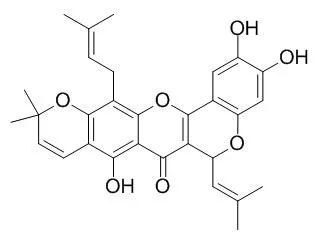| In vitro: |
| PLoS One. 2016 Sep 1;11(9):e0161767. | | Photoprotective Effects of Cycloheterophyllin against UVA-Induced Damage and Oxidative Stress in Human Dermal Fibroblasts.[Pubmed: 27583973 ] | Ultraviolet (UV) radiation, particularly ultraviolet A (UVA), is known to play a major role in photoaging of the human skin. Many studies have demonstrated that UV exposure causes the skin cells to generate reactive oxygen species and activates the mitogen-activated protein kinase (MAPK) pathway. Previous studies have also demonstrated that Cycloheterophyllin has an antioxidant effect and can effectively scavenge free radicals.
METHODS AND RESULTS:
Extending the aforementioned investigations, in this study, human dermal fibroblasts were used to investigate the protective effect of Cycloheterophyllin against UV-induced damage. We found that Cycloheterophyllin not only significantly increased cell viability, but also attenuated the phosphorylation of MAPK after UVA exposure. Furthermore, Cycloheterophyllin could reduce hydrogen peroxide (H2O2) generation and down-regulate H2O2-induced MAPK phosphorylation. In the in vivo studies, the topical application of Cycloheterophyllin before UVA irradiation significantly decreased trans-epidermal water loss (TEWL), erythema, and blood flow rate.
CONCLUSIONS:
These results indicate that Cycloheterophyllin is a photoprotective agent that inhibits UVA-induced oxidative stress and damage, and could be used in the research on and prevention of skin photoaging. | | J Nat Prod. 1996 Sep;59(9):834-8. | | Novel antiplatelet constituents from formosan moraceous plants.[Pubmed: 8864236 ] |
METHODS AND RESULTS:
Sixteen constituents from Formosan Moraceous plants were tested for their antiplatelet activities in rabbit platelet suspension and human platelet-rich plasma. Cycloartocarpin A, Cycloheterophyllin, broussochalcone A, kazinol A, broussoaurone A, and broussoflavonol F showed strong inhibition of arachidonic acid (AA)-induced platelet aggregation.
CONCLUSIONS:
Of the compounds tested, broussochalcone A exhibited the most potent inhibition of platelet aggregation induced by AA (IC50 = 6.8 microM).
The antiplatelet effects of Cycloheterophyllin, broussochalcone A, kazinol B, broussoaurone A, and broussoflavonol F are partially due to an inhibitory effect on cyclooxygenase. |
|






 Cell. 2018 Jan 11;172(1-2):249-261.e12. doi: 10.1016/j.cell.2017.12.019.IF=36.216(2019)
Cell. 2018 Jan 11;172(1-2):249-261.e12. doi: 10.1016/j.cell.2017.12.019.IF=36.216(2019) Cell Metab. 2020 Mar 3;31(3):534-548.e5. doi: 10.1016/j.cmet.2020.01.002.IF=22.415(2019)
Cell Metab. 2020 Mar 3;31(3):534-548.e5. doi: 10.1016/j.cmet.2020.01.002.IF=22.415(2019) Mol Cell. 2017 Nov 16;68(4):673-685.e6. doi: 10.1016/j.molcel.2017.10.022.IF=14.548(2019)
Mol Cell. 2017 Nov 16;68(4):673-685.e6. doi: 10.1016/j.molcel.2017.10.022.IF=14.548(2019)